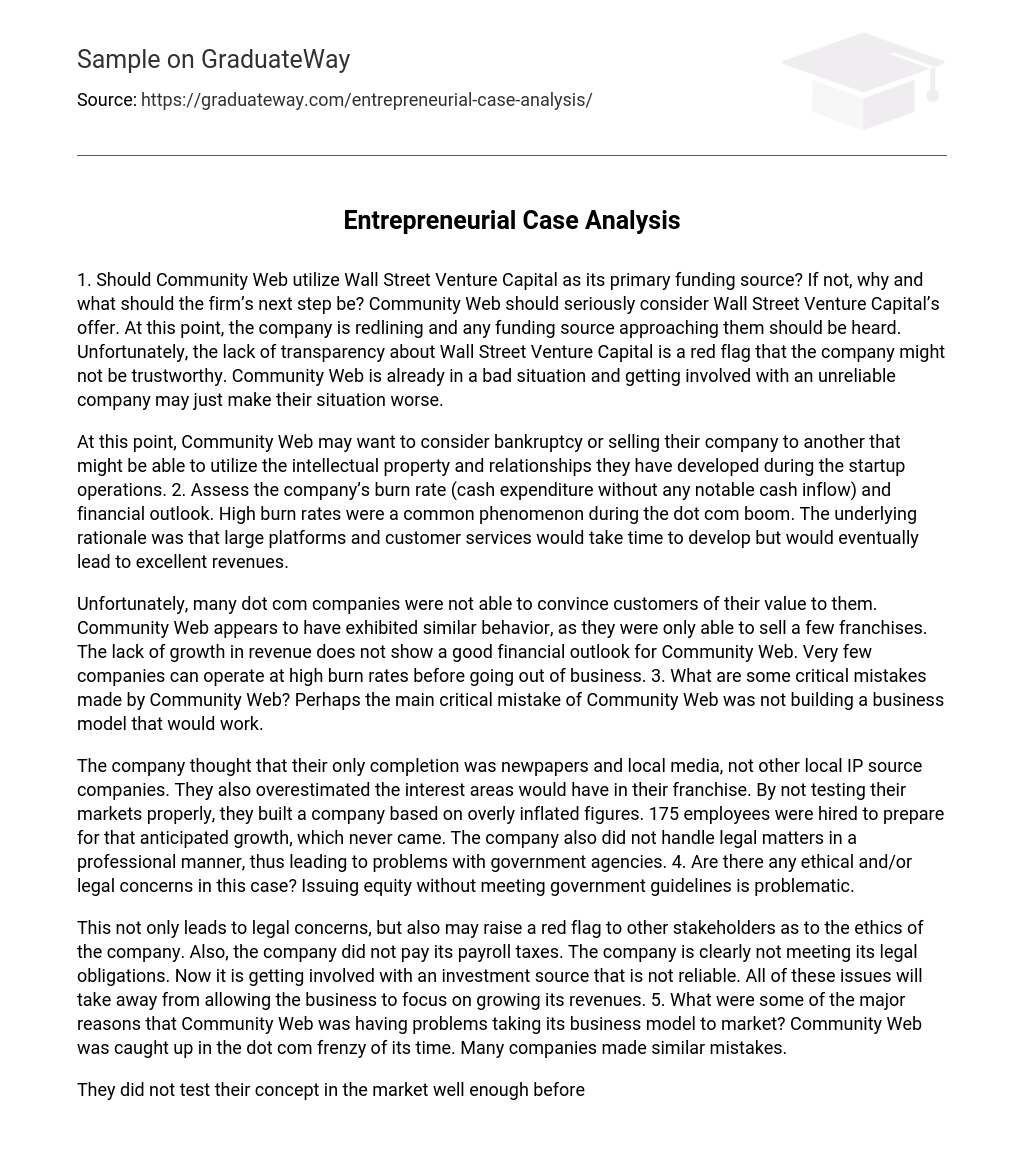Should Community Web choose Wall Street Venture Capital as its main funding source? If not, what should the company do next? Community Web needs to carefully evaluate the offer from Wall Street Venture Capital. Given the current financial difficulties, it is important for the company to consider all funding options. However, the lack of transparency surrounding Wall Street Venture Capital raises concerns about their reliability. Community Web is already in a precarious position, and partnering with an untrustworthy company could worsen their situation.
Community Web may want to consider bankruptcy or selling their company to another that can utilize the intellectual property and relationships they have developed during the startup operations. It is important to assess the company’s burn rate (cash expenditure without any notable cash inflow) and financial outlook. During the dot com boom, high burn rates were common as the belief was that developing large platforms and customer services would take time but ultimately generate excellent revenues.
Regrettably, numerous dot com companies failed to persuade customers of their worth. Community Web seems to have displayed similarities in this regard, as they only managed to sell a limited number of franchises. The limited revenue growth signifies an unfavorable financial outlook for Community Web. Operating at high burn rates before facing closure is a situation that very few companies can endure. 3. What are some crucial errors committed by Community Web? One could argue that the primary crucial error of Community Web was the failure to construct a viable business model.
The company underestimated its competition, believing that only newspapers and local media were its rivals, not other local IP source companies. Additionally, they overestimated the interest areas would have in their franchise, resulting in a company built on inflated figures due to inadequate market testing. To prepare for the expected growth that never materialized, they hired 175 employees. Furthermore, the company mishandled legal matters, leading to issues with government agencies.
In this case, there are ethical and legal concerns. Issuing equity without meeting government guidelines is problematic.
The company is facing legal concerns and ethical red flags, which affects other stakeholders. They have also failed to pay payroll taxes, indicating a failure to meet legal obligations. Additionally, they are now involved with an unreliable investment source. These issues hinder the company’s focus on increasing revenues. Another challenge Community Web encountered was getting caught up in the dot com frenzy, a mistake made by many other companies at the time.
Before building the business, the company failed to adequately test their concept in the market. It is crucial for a business to adhere to business fundamentals in order to survive, regardless of the technology and market involved. Their business model was incorrect due to their overly optimistic outlook on customer interest in their services. Furthermore, they lacked a reliable business plan to present to potential investors. Despite projecting a billion dollar business, they only managed to secure $1.6 million in investment, indicating that their research and projections were unrealistic.
Community Web encountered difficulties in obtaining financing for several reasons. They would have benefited from having a business plan that was supported by solid market research. It seems that the company relied heavily on a strong hunch of their potential success, which is not enough for investors who require concrete market and financial evidence. The combination of a high burn rate, a lack of professional leadership, and unreliable projections made the company unappealing to potential financers.
7. The effectiveness of the Community Web business plan in raising capital should be evaluated. According to the case, the plan was continuously modified and eventually became detached from the company’s daily operations. The business evidently lacked direction, as proven by the legal and ethical dilemmas it encountered. The plan relies more on secondary data rather than solid primary data, which hampers its credibility in verifying financial projections. Insufficient reliable data undermines potential investors’ confidence in financing the business.
The company’s unrealistic outlook is evident in the Business Model section. It anticipates selling services to small areas that larger companies have overlooked. However, there could be a valid reason why larger companies have not serviced these areas. It seems that local community coordinators would need to put in significant effort to operate the service, but revenues in these areas may be limited. Once again, the company’s basic financial model fails to generate sufficient revenues to cover its costs.





